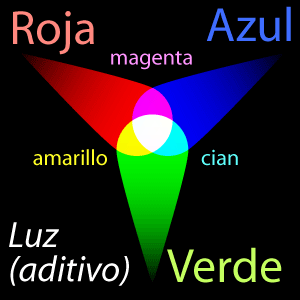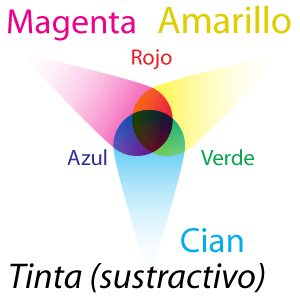The CMYK or CMYK process
Based on the semitone system and the optical illusion that sustains it, a system was developed to print color images with a reasonably acceptable fidelity called four-color process.

Additive color mixture
The ‘additive’ system of creating colors. They are adding lights of primary colors (red, green and blue), and the sum creates the white. The intermediate colors of the three primary ones are the complementary ones (magenta, yellow and cyan). The process is based on the theory of color that says that the spectrum of light emissions perceptible by the human eye can be decomposed into a series of basic colors: three additives and three subtractive ones. The game of mixtures between these stimuli allows to represent the colors so that the human eye perceives color tones up to the limit of its capacity. A system based on the three additive colors (Red, Green and Blue) is not possible in the world of printing since they are based on adding light (something that a fluid like ink can not do).

Substractive mixture of colours
The ‘subtractive’ system of creating colors. Ink is added from the primary colors (magenta, yellow and cyan), and the sum is subtracting light to create black. The intermediate colors of the three primary ones are the complementary ones (red, green and blue). However, it is possible to use the three subtractive colors (Cyan, Magenta and Yellow) as a starting point. In principle it is enough to use a support white enough to represent 100% light and add inks to subtract light until you reach 0% light (ie 100% black). In theory if we superimpose three halftone frames of those three subtractive colors we can obtain any color image capable of being printed in series with a “sufficient” fidelity. And if that is true, why does the Negro need it? Well, for two good reasons.
The first is that the theory is based on supposed “pure” cyan, magenta and yellow inks, “ideals” that do not exist in reality. The best inks the most they get is a dark tone of brownish hue of dirty aspect to the human eye (which is very perceptive in what to the distortion of tones that psychologically “should” be neutral). For that we use a fourth black ink, to achieve a true black, with strength in the shadows.
The second reason is more pedestrian. We use black instead of a combination of the three inks because it is cheaper to use one ink than three. That is why we also use black, because it is expensive to try to keep the record (perfect superposition) of three plates to produce things (images, text, lines) that we can achieve very simply with only one plate. The process system is often called “CMYK” by the English initials of Cyan (cyan), Magenta, Yellow (yellow) and Key (key, since in traditional printing the black color was “the key color”). Sometimes you will also see it with the Spanish acronym CMAN.
Source: gusgsm.com







